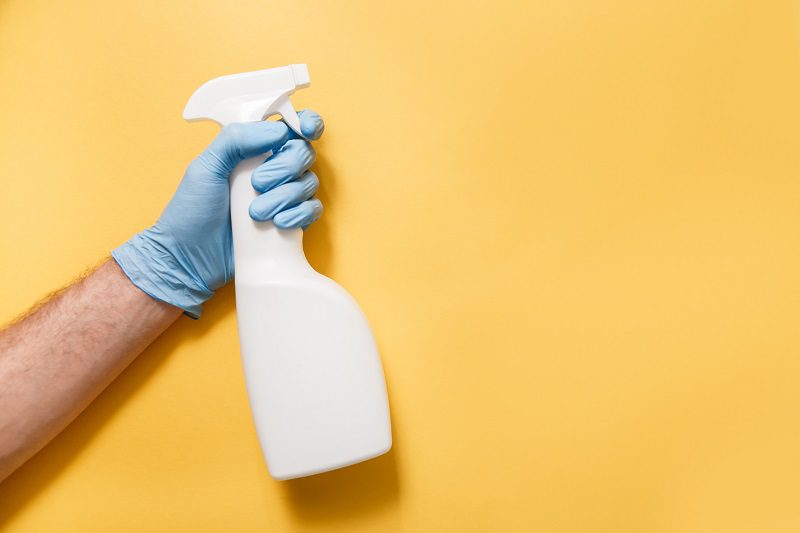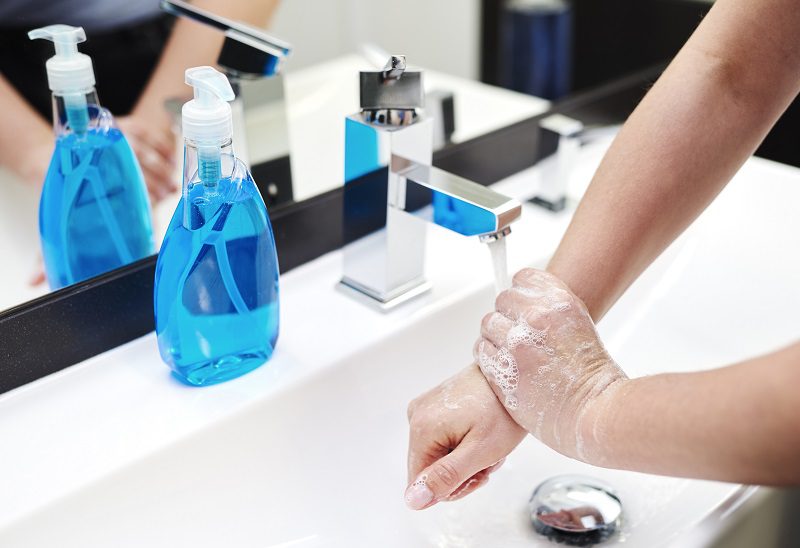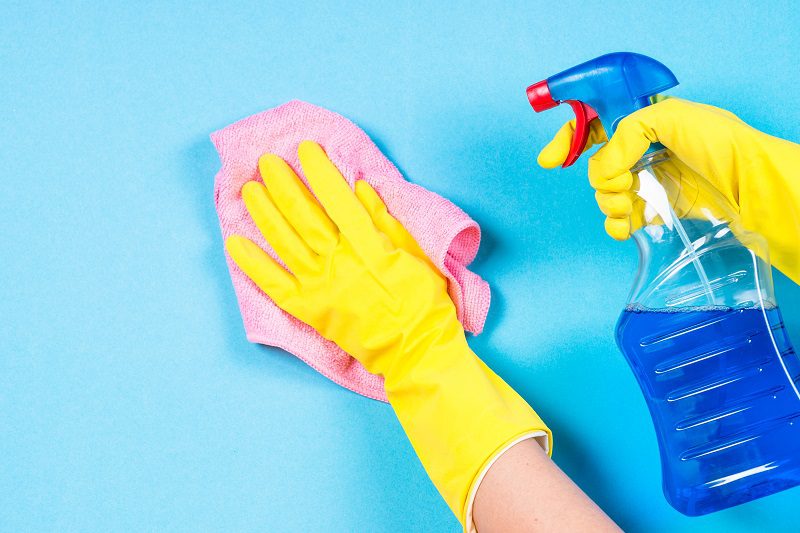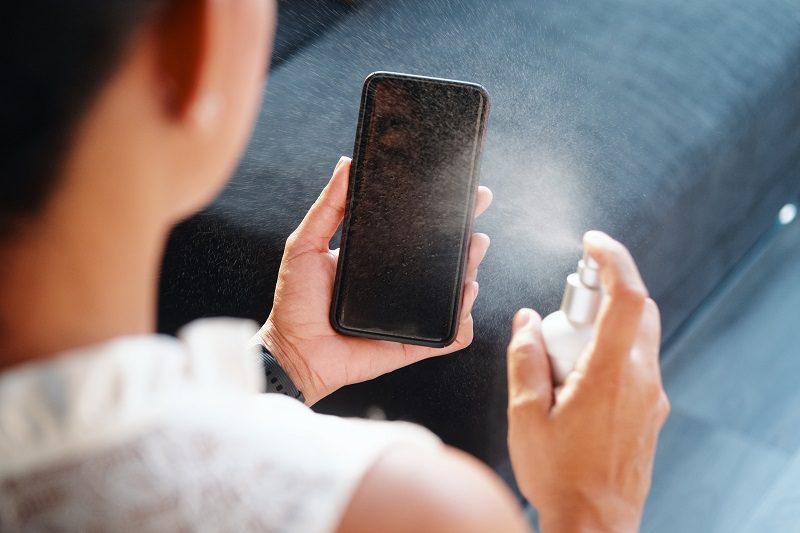
Using disinfectants wrong is very common these days. From using the wrong products to not leaving them long enough to work its magic, these are the mistakes you need to avoid in order to stay safe and kill viruses.
First of all, it’s important to make the difference between cleaning and disinfecting. Now it is more important than ever to disinfect your home properly, but there’s a good chance that you might have no idea how to do that. “While cleaning removes viruses, disinfection neutralizes them with chemicals, so you will need to both clean and disinfect,” says Elena Ledoux, founder of the Las Vegas-based Superb Maids. “The most effective cleaning method is soap and hot water. For bacteria, soap will force the microbes to release from surfaces and break water tension, moving the germs to a rag or down the sink.”
Viruses such as COVID-19, SARS, and MERS have a lipid (fatty) layer, meaning it’s a lot more difficult to kill than other viruses. “According to the Food and Drug Administration (FDA), soap destroys this lipid layer, stopping the virus from being able to infect you,” Ledoux explains. “Disinfectants that work [on surfaces] are bleach, alcohol, and hydrogen peroxide. Vinegar, ammonia, witch hazel, and tea tree oil do not work as disinfectants.”

You often use the bleach for a quick cleanup
Bleach can also do its job but only if you use it correctly. “Bleach generally takes four-plus minutes of contact time to kill viruses,” says Ledoux. “If you use bleach, I actually recommend a 10- to 15-minute dwell time.”
Alcohol concentrations of over 60 percent, on the other hand, take only 30 seconds of contact time to kill coronavirus.
You use a disinfectant with a low alcohol concentration
Eco-friendly products are great, but it’s always important to check the alcohol concentration. A lower alcohol concentration won’t be enough to kill COVID-19. That’s why it is crucial to read labels, especially now.
When it comes to alcohol-based products, you should be looking for products that have at least a 70 percent alcohol concentration. “Opt for cleaning alcohol itself, which is normally sold in pharmacies,” advises Ledoux. “The content is important because the higher concentration kills the coronavirus in less than one minute. Plus, it’s effective, doesn’t leave a residue, and evaporates.”

You don’t read the fine print
Not reading the label on how to use a product is a common mistake made by most consumers, says Ledoux. “Professional cleaners follow the label. The manufacturers perform extensive testing and make their instructions based on that,” she notes. “Many consumers don’t read those labels, and, as a result, don’t allow sufficient dwell time for the product to be effective. If we use a disinfecting spray that’s labeled for two to three minutes but wiped it after 10 seconds, there will be very minimal, if any, cleaning and sanitizing effect.”
For instance, here are the instructions on a can of Lysol: “Pre-clean surface. Spray surface until thoroughly wet. Leave for 2 minutes before wiping.”
You ignore your home’s biggest problem areas
“While floors get dirty, we typically aren’t going to get sick from dirty floors,” says Trisha Lake, owner of TLC Cleaning in North Dakota and Minnesota. “Light switches and doorknobs are way more likely to get us sick. Break out those toothbrushes and start scrubbing those light switches two-plus times per week.”
You use disinfecting wipes instead of a spray
“Wipes are convenient to keep in your purse, briefcase, or backpack for use when you are away from home and need to touch surfaces like shopping carts, door handles, and so forth,” explains Jim Epstein, CEO of Intercon Chemical & Clearly Better, which makes PURE Hard Surface Disinfectant. “When at home, though, it is best to use a spray disinfectant. Wipes become dirty quickly, and you can overload a wipe, so its disinfectant material loses effectiveness.”

You don’t wash your hands before cleaning
If you didn’t know this, you don’t just need to wash your hands when you come in from outside, you also need to wash them before cleaning around your house. If you skip this important step, you’re introducing germs into what should be a clean environment. Moreover, before you get started, Lake recommends washing your hands for 20 seconds with soap and water. It’s also important to wear a pair of disposable gloves while cleaning.
“When cleaning, you’re going to come in to contact with many different germ-ridden surfaces,” says Lake, so this gives you some extra protection. Lake recommends Nitrile Exam & Safety Gloves: “They’re my personal favorite disposable gloves because they tend to cause less allergic reactions and hold up better than latex or vinyl.”
You waltz right past Magic Erasers
Not only do they remove any kind of marks from your walls when no other product can, but they also can also aid your disinfecting efforts. “While they do not disinfect, they make it easier to get the dirt off of surfaces so a disinfectant can do the work,” says Lake. “I absolutely love Magic Erasers and use them every single day.”
You can use them on the areas that need a good cleaning, such as countertops, toilets, and door handles, before applying your disinfectant of choice.

You use the same rag to clean multiple surfaces
You’re doing this every day without knowing that it actually does more harm than good. Cleaning multiple surfaces while using the same rag only moves the germs from one place to another, contaminating your house. Instead, use a new rag for each surface.
“For example, we use brown microfiber to clean toilets and the floor right by the toilet. Those then get double sanitized in the wash,” she explains.
You forget about your remote control
Please, don’t forget to clean your remote control! There’s a very specific way to do it, according to Consumer Reports. Firstly, you have to remove the batteries. Then turn the remote upside down so that the buttons are facing downward, and “shake it or tap it against your palm to dislodge any debris that might have fallen between the keys.”
“When applying the disinfectant, don’t spray any solution directly onto—or into—the device. Use a wipe instead, or a paper towel or disposable cloth moistened with solution, to gently clean the outer shell.”

You don’t believe in DIYs
It’s very hard to find disinfectants these days, as many are sold out in almost every store. However, there are some DIY recipes out there that can actually work. “If you’re in a pinch or short on product, rubbing alcohol, diluted with water, will work,” says Lake. “Use a 50/50 dilution ration of 50 percent water and 50 percent rubbing alcohol.”
You use Windex everywhere
Glass cleaner is good for windows, mirrors, and some other glass surfaces, but remember they are not disinfectants, according to Epstein. Glass cleaners are not intended to kill germs. “My Big Fat Greek Wedding aside, it’s just a glass cleaner and not a disinfectant,” he says. “When you need to disinfect, especially for ‘high-touch surfaces,’ use a low-toxicity, people-friendly, hospital-grade disinfectant that can be used to both clean and disinfect those hard surfaces: door handles, light switches, bathroom fixtures, and handles, kitchen surfaces, and more.”

You forget to disinfect your phone
You’ve probably known already that your phone is full of germs. But how do you clean it properly? “Apple has recently changed its support page to say that it’s OK to use a wipe on your cell phone that contains 70 percent alcohol,” says Harris. “However, don’t use straight alcohol! It can damage a screen’s protective coating.” For phones and other small devices, she also recommends Phone Soap and Homemedics’ Phone Sanitizer, which use UV-C lights to kill germs.
“Seventy percent is best,” she says. “Either spray or use a cloth to wipe down surfaces such as phones, printers, and keyboards—but use a very light amount when doing keyboards.”
You use baby wipes on everything, not just babies
If you find yourself using baby wipes to clean surfaces in your house you should know that those wipes are not disinfecting anything. “They contain gentle ingredients because they are used on skin and moisturizing ingredients meant to soothe,” says Harris. “While they may be good for general quick cleaning, they are not meant for killing germs and viruses.”
The same thing applies for general cleansing wipes, she adds. These wipes are regulated by the cosmetics industry, while wipes that disinfect on “inanimate” surfaces, such as a mobile phone, are regulated by the United States Environmental Protection Agency (EPA).























